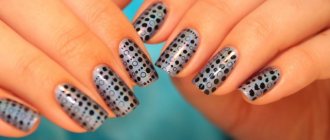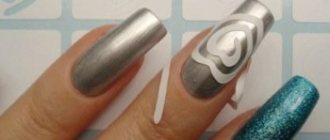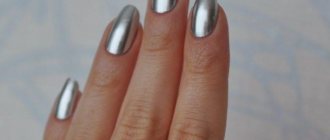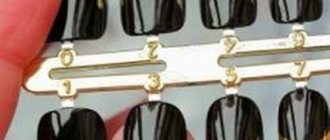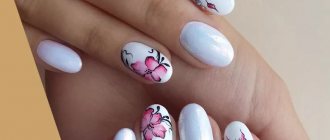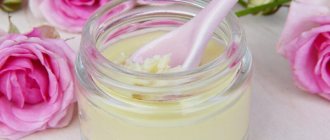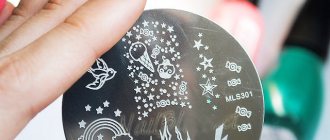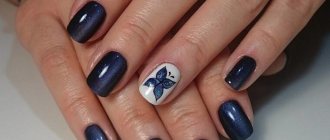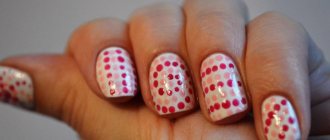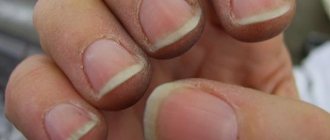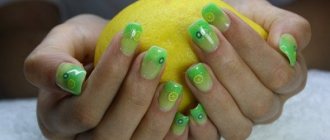A stylish and well-groomed appearance is an important condition for a successful modern woman. One of the components of this image is a neat manicure. However, not every girl has the opportunity to visit salons or at least devote enough time to creating a manicure at home.
It is for such women that they came up with a special method that allows you to quickly and in the shortest possible time give your nails a neat and original look - stamping.
What are nail stamps and stamping?
Stamping is a special way of applying a design to nails. This method involves the use of a special stamp with a finished image, which is imprinted on the nail plate. This is very convenient, especially for those who do not have sufficient artistic skills.
The nail stamp itself is a special soft plate onto which the design is transferred from an engraved hard disk.
To create a manicure using the stamp method, you can use ready-made kits that are sold in professional salons or cosmetic stores. You can also make your own stamping stamp at home. However, it is necessary to take into account some subtleties in its manufacture, and also use only suitable materials, otherwise the result will be far from perfect.
Advantages
Stamping is a relatively new technology in nail art that allows you to achieve an attractive result in the shortest possible time. The main advantage of this manicure method is its simplicity.
Not so long ago, in order to give her nails an original appearance, a girl had to spend a lot of time on the procedure or, without the necessary artistic talents, go to expensive salons. With the advent of stamping, this problem was solved by itself.
The advantages of this manicure method are:
- Ease of use and accessibility. To apply an original pattern to your nails, you just need to purchase a stamping kit, which you can use more than once.
- Positive result. The clear and beautiful image obtained using stamps does not differ in appearance from a salon manicure.
- There is no need to spend a lot of time manually applying the image.
- A variety of designs that you can apply to the stamp yourself.
Flaws
The stamping method allows you to give your nails a well-groomed and original look without spending a lot of time on it. Despite this, the procedure also has a number of negative aspects.
The main disadvantages of stamping are:
- It is impossible to immediately, the first time, apply a complex pattern to your nails. Therefore, beginners are recommended to choose the simplest image options.
- Quite a high cost of quality stamps. Low quality devices also have a lower cost, but they can be used no more than 1-2 times.
- The need for strict adherence to all stages of the procedure. In particular, after applying the image, it is important to let the drawing dry completely and only then apply the fixing layer. Otherwise, the clarity of the drawing is lost.
Stamping kits
Kits, which include all the necessary accessories, can be purchased in special stores or nail salons. The easiest way, of course, is to buy ready-made, but you can also buy it in parts - as needed.
The set includes the following tools:
- A stamping disk is a special metal plate on which patterns are engraved. When purchasing, it is important to pay attention not only to the complexity of the design, but also to the depth of the engraving (the deeper the recesses, the better).
- A scraper is a special tool used to remove varnish residues from the surface of a metal disc. Instead of a scraper, you can use any solid device, such as an unnecessary plastic card.
- A soft stamp used to transfer a design from a metal surface to the nail plate.
- Paints with a dense consistency. Instead, you can use thick nail polishes.
What you need to create a manicure
In addition to the devices indicated above, the procedure will require other important elements.
You need to prepare in advance:
- A base coat that should be a different color from the paint used to create the design (it is best to use the most contrasting color shades).
- The topcoat is a transparent topcoat that is applied at the end of the procedure. Using a fixing varnish will allow you to maintain the original appearance of your manicure for a long time.
- Cotton swabs and nail polish remover, necessary for correcting the result (for example, to remove excess polish from the skin around the nails), as well as for cleaning tools.
Stamping - a new technology for quick manicure
Every lady who takes care of her nails has already heard about the new technology, and if you are still unfamiliar, then let’s figure out together what kind of miracle product this is for an individual quick manicure.
Nail art (Stamping art) is a type of manicure that involves applying stamps to the nail plate using tools that we will talk about later. It is significantly different from brush painting. You get an interesting, intricate decor on your nails, which is not always possible for a master, since using the stamping technique you can apply the smallest design, the finest pattern. In addition, the decor on the nails is completely identical and lasts quite a long time.
Girls who have once tried to do stamping art at home will no longer be able to refuse the opportunity to inexpensively and beautifully flaunt a new manicure every day.
Color combinations in stamping
The main rule when choosing color shades is contrast. So, if you plan to apply a light base, then it is recommended to choose dark tones to create a picture. Conversely, if the main color is dark, then an image made with a light varnish will look more neat and attractive.
Another feature: it is recommended to choose varnishes that have a matte finish as a base. In this case, the drawing will be brighter, clearer and more expressive.
The most commonly used option is when a dark pattern is applied to a light base layer. For example, black, blue, and red patterns are most harmoniously combined with a white base. The beige base looks more restrained and casual. To create a picture in this case, it is best to choose black, blue, and emerald colors.
Silver varnish as a base harmonizes with the pattern of purple, hot pink, and blue colors. For a red or pink base, images made in black, white, blue, brown, gold or silver colors work well.
For a dark base (such as blue or black), it is recommended to choose designs in white, pink, silver or gold.
What to look for when choosing
An important point in creating attractive nail art is choosing a suitable and high-quality set. The quality of the result depends largely on this. First of all, you need to pay attention to the quality and clarity of the engraving applied to the metal surface.
Equally important are the correctly selected stamp and varnish that will be used to create the base and image. The surface of the stamp must be dense. If it has a porous structure, it is impossible to achieve image clarity in the future.
Types of stamps
Stamps for applying designs to nails can be either original, produced by well-known brands, or produced with the “no name” mark.
Branded tools are usually of better quality, but also have a higher cost. You can also choose a high-quality option from among non-original stamps, but to do this you need to pay attention to various nuances, in particular, the material and its structure, the number of working surfaces, and the color of the product.
Stamps are made of rubber or silicone. Rubber products are less elastic and more durable. Such devices are best suited for applying small-sized graphic elements. In addition, the rubber surface allows you to add certain images yourself, which means you can use them to create the most original manicure.
Silicone stamps are more convenient to use - with their help you can create a clearer and more voluminous design. Silicone is considered a softer material than rubber. It adheres better to the surface of the nail, which means it allows you to apply a clear image to the entire nail plate.
Depending on the available number of working areas, it is customary to distinguish single-sided or double-sided stamps. The first option is considered simpler and more budget-friendly; it has only one working surface on which the drawing is applied.
Double-sided stamps typically have different densities and surface textures, making them more versatile.
The color of the stamp can be colored or transparent. The colored product comes with additional pads that can be changed as needed. On a transparent stamp, the design remains as clear as possible for a long period of time.
Which varnish is better to use
Choosing the right polish is also an important point in creating beautiful nail art. At the same time, it is not at all necessary to spend money on purchasing special coatings, which can easily be replaced with regular nail polish. However, when choosing, you must give preference to the thickest, matte, pigmented coatings.
To create an attractive manicure, gel polish is most often chosen. A type of coating such as shellac is not suitable for stamping - it spreads over the surface of the stamp, as a result of which the design turns out blurry and unclear, and small details of the image may not be drawn.
Popular manufacturers
The modern beauty industry offers women many options for high-quality and inexpensive products for creating a good “correct” manicure using the stamping method.
When choosing a varnish, it is recommended to pay attention to products from such brands as:
- Konad - the company also produces high-quality stamping kits;
- Kand Nail;
- El Corazon;
- Golden Rose.
Interesting ideas for stamping
Stamping looks great on short nails, photo below.
Nail ideas with stamping:
- Silver, white or gold patterns on a black varnish layer.
- Blue floral patterns on a white background using the Gzhel technique.
- Openwork white drawings on a transparent coating.
Thus, it is not difficult to create designs on nails using stamping, the main thing is diligence and the desire to master the technique.
We recommend visiting our Manicurist Forum , where you can ask questions or chat about interesting topics!
How to do stamping correctly
To do stamping, first of all you need to prepare your workplace - make sure that there are all the tools on the table that you will need in the process of creating a manicure. It is important to correctly select colors that will successfully combine with each other, and only after that you can proceed directly to the procedure.
Regular gel polish
An important point is preparing nails for coating. First of all, it is necessary to treat the cuticle, shape the nails and degrease the surface. For this, in addition to regular hand washing with soap, special liquids are also used.
The procedure then includes the following steps:
- Application of primer. The primer is a transparent base that provides a better application of the base color layer. After using the primer, you must let it dry completely.
- Applying a colored base in one or two layers (this depends on the consistency and pigmentation of the composition).
- Processing the base layer with a special brush (sealing).
- Drying nails in a special UV lamp.
- Treating the metal surface and the stamp itself with acetone (this is necessary to remove dirt, dust and varnish residues from the working surface).
- Applying varnish to a metal disc: take a small amount of coating, which is evenly distributed in a thin layer over the surface, filling all the details of the engraved design.
- Transferring the image to the soft surface of the stamp. To do this, it is pressed tightly against a metal disk so that all the details of the image are imprinted on it.
- Drawing on nails. The stamp is firmly applied to the desired area, after which it is rolled over the surface of the nail, transferring the image.
- Drying. First, you need to let the design dry for a few minutes, and then you can dry your nails using a UV lamp.
- Applying the final layer. The top coat should be transparent and may also contain fine glitter.
- Final drying.
Reversible gel polish
The reverse stamping method allows you to create a more complex and original design. However, this procedure is considered more complex and requires certain skills and experience to perform it.
Main stages:
- Basic manicure (cuticle removal, shaping, degreasing).
- Apply primer and colored base coat.
- Drying.
- Applying varnish to a metal disc, spreading the coating using a scraper.
- Transferring an image to a stamp.
- Additional drawing of details directly on the stamp surface. To do this, use special thin manicure brushes.
- Drying the stamp in a UV lamp (no more than 20 seconds).
- Removing the resulting pattern from the surface (use tweezers).
- Transferring the image to the nail, securing the result with a top coat.
- Final drying.
Stamping with acrylic paints
Despite the fact that gel polish is a very affordable means of creating a manicure, the question of what can replace it remains relevant. The most popular alternative medium is acrylic paints. They compare favorably with their cost, but do not always have the desired thickness and consistency. Therefore, unfortunately, it is impossible to guarantee a positive result.
The steps of stamping using acrylic coating are standard; the sequence of actions does not differ from the procedure using gel polish. However, there is one important point: before using the product, it is recommended to hold the jar of the composition open for 10 minutes - this will make the paint thicker and more suitable for use.
Stamping: instructions for implementation
Stamping must be carried out strictly according to the instructions in order for the result to be perfect.
Preparing your nails before applying polish
Before applying stamping varnish, it is necessary to clean with a product containing acetone.
Also, do not use polish with glitter for the base coat. The pattern is not noticeable against such a background.
First you need to thoroughly wash your hands, dry them, remove the cuticles, degrease your nails and cover them with a base and regular varnish.
Technique for stamping on regular varnish
You can stamp your nails with regular polish. However, it is important to remember that before directly applying the design, you should make sure that the nail polish is completely dry.
It is necessary to proceed according to the following scheme:
- Remove the thin film from the discs.
- Degrease the scraper, stamp and plate.
- Choose a thick varnish.
- Apply a special product to the area around the nail to protect the cuticle.
Apply cuticle protectant - Apply the varnish to the plate (stencil) in two or three quick movements, otherwise the material will begin to harden while the master applies several small layers.
Apply varnish to the stencil - Without delay, run a scraper over the stamp to remove all excess, pressing it tightly against the stencil.
The varnish remains only in the recesses. Pressing too hard may remove all the varnish from the engraving. But too light pressure will not be able to remove the extra layer of varnish. Using a scraper, run along the stamp to remove excess varnish. - Apply the stamp to the design using a gentle rolling motion.
Using rolling movements, press the stamp onto the stencil. - Quickly apply the stamp to your nails using a rolling motion from roller to roller, making sure that the image is completely imprinted on the stamp.
Transferring the design from the stamp to the nail - Remove the cuticle protector and use a brush or cotton swab dipped in nail polish remover to clean off excess polish.
Remove the cuticle protector. - Apply sealer or clear varnish.
Result - Clean the disc and stamp from varnish with acetone liquid.
Stamping technique on gel polish
How to make stamps on nails with gel polish (shellac)? The technology is a combination of two techniques: first you need to degrease your nails, apply a base, dry, apply gel polish, dry the layer, then apply a fixative and remove the sticky layer. Then you can draw with a stamp. According to the scheme described above, the design is transferred to the stamp and then to the nail. The stencil is pre-painted either with ordinary varnishes or with special paints. After drying, the nail is again covered with a fixative and sent to a UV lamp. Then the plates are treated with a degreaser.
Reverse stamping technique
This type of stamping is different in that after the design is reprinted onto a stamp, it is decorated with paints or varnishes on the same stamp. After the drawing dries, it is covered with transparent varnish. When the layer dries, you need to transfer it using a dot to the nail that was previously coated with gel polish and top coat without removing the sticky layer. The film should be pressed from the base of the nail to its free edge. Then smooth along the edges. The excess is cut off with nail scissors and the edges are tucked in using an orange stick. Then the plate is covered with topcoat.
The nuance of how to do nail stamping at home is that the paint should be shaken beforehand, since the acrylic pigment always sinks to the bottom of the bottle, and there is a possibility that the color may turn out less bright. Otherwise, the procedure is identical to stamping with regular varnish.
- Apply stamping varnish to the selected pattern.
- Remove excess with a scraper.
- Transfer the drawing to the stamp.
- We paint the space between the lines of the drawing with varnishes or acrylic paints. The front side will be at the bottom.
- Let the varnish dry and apply a thick layer of topcoat and leave the stamp for 20 minutes to allow the design to dry thoroughly.
- After the top on the stamp has dried, carefully pick it up with tweezers, as a result you will get a thin film with a pattern.
- Apply protective oil or varnish to the cuticle, and apply a clear varnish or base coat to the nail.
- We apply the film with the pattern on the nail with the front side up, press it and trim off the excess.
- Cover the drawing with topcoat.
Recommendations
The main recommendation is to use a high-quality color coating for applying both the base layer and image elements.
There are other important features that must be observed:
- It is necessary to remove the protective film from the surface of the metal disk (otherwise the design will spread).
- Use nail polish remover that does not contain oil elements.
- Quickly apply the varnish to the surface of the disk and stamp so that the composition does not have time to dry.
- Dry each subsequent layer thoroughly.
How to care for your stamping kit
After you have given yourself an interesting manicure with designs, it is important to properly process the tools and also send them for storage in a suitable place.
If we talk about stamping varnish, then it is better to send it to a dark place with a cool or moderate temperature. There it will stay fresh longer.
The pattern disc should be cleaned immediately after use. Do this with nail polish remover. You should not let the remaining varnish dry in the embossed patterns, as this will ruin their evenness. The next time you want to stamp, you won't get the best results.
If the varnish has dried out and you can’t wipe it off, you don’t need to scratch anything. It is better to soak the entire plate in nail polish remover. This will definitely help.
